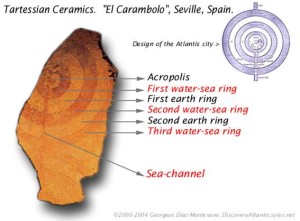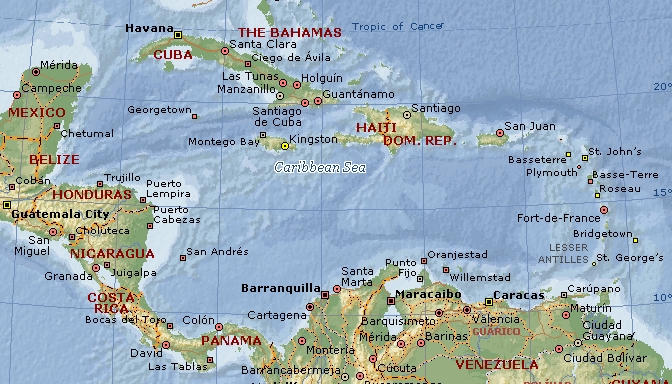Brad Yoon
Yoon, Jay *
 Jay Yoon is the American author of the short ebook, Atlantis Shrugged [1371] , also known as Atlantis: The Underworld(b). His views on Atlantis are also available on the Internet(a) where he supports the Caribbean Basin as the location of Atlantis, which he believes was submerged around 9600 BC.
Jay Yoon is the American author of the short ebook, Atlantis Shrugged [1371] , also known as Atlantis: The Underworld(b). His views on Atlantis are also available on the Internet(a) where he supports the Caribbean Basin as the location of Atlantis, which he believes was submerged around 9600 BC.
He claims that originally the Basin, although nearly 13,000 feet below sea level, was kept dry by the range of surrounding mountains which was subsequently breached by the earthquake referred to by Plato. Yoon outlines his theory in the form of a Platonic Dialogue, in which the participants are Solon, Aristotle and Critias.
For anyone interested, Yoon has supplied the following co-ordinates for his chosen location for Atlantis – 17°09’54.95″ N 65°03’32.64″ W.
In my opinion his basic idea is fanciful. Why would Yoon’s Atlanteans send an army climbing mountains over 13,000 feet, in the Caribbean, to launch an attack in the eastern Mediterranean, over 5,000 miles away, at a time when suitable ships did not exist in order to attack Athens and Egypt, which did not exist either? Would it not have made more sense to expand into North and/or South America from the Caribbean?
It is more likely that if a dry Caribbean Basin did exist in 9600 BC, it was flooded by the rising sea levels resulting from the melting icecaps.
In March & April 2016, Yoon, then Brad and later Brady Yoon, rehashed his Caribbean theory on the Ancient Origins website(e). In one(d) he discusses the Deluge and its possible connection with the demise of Atlantis. In the concluding paragraph of the other(c) he admits that “all of this speculation could be entirely baseless”, a view I enthusiastically endorse.
Nevertheless, Yoon has written an interesting article(g) on the origin of Utah’s Great Salt Lake. Originally believed to be the result of the biblical Deluge, today it is claimed that the salt came from tributary rivers which remained after the water evaporated. Yoon offers strong evidence that the salt came from seawater and by extension reinstating the Deluge theory!
Jason Colavito has published a critique of some of Yoon’s earlier posts on Ancient Origins(f).
Yoon has now assumed the title of ‘The Atlantis Expert’ and has posted a number of YouTube videos(h) which claims to support his Atlantis theories!
(a) https://y2jayblog.wordpress.com/author/y2jay2013/
(b) https://www.amazon.co.uk/Atlantis-The-Underworld-ebook/dp/B00B1JJDTS
(f) https://www.jasoncolavito.com/blog/rings-of-power-do-concentric-circles-prove-atlantis-real
(h) https://www.facebook.com/The-Atlantis-Expert-101925171495708/ (link removed) *
Concentric Rings *
The Concentric Rings or other architectural features extracted by artists from Plato’s description of the capital of Atlantis have  continually fascinated students of the story and many have attempted to link them with similar ancient features found elsewhere in the world as evidence of a widespread culture. Stonehenge, Old Owstrey, Carthage and Syracuse have all been suggested, but such comparisons have never been convincing. Diaz-Montexano has recently published(a) an image of a fragment of pottery found near Seville in Spain that shows concentric circles and insists that it is a symbol of Atlantis. Ulf Erlingsson has made a similar claim regarding some concentric circles carved on a stone basin found at Newgrange in Ireland.
continually fascinated students of the story and many have attempted to link them with similar ancient features found elsewhere in the world as evidence of a widespread culture. Stonehenge, Old Owstrey, Carthage and Syracuse have all been suggested, but such comparisons have never been convincing. Diaz-Montexano has recently published(a) an image of a fragment of pottery found near Seville in Spain that shows concentric circles and insists that it is a symbol of Atlantis. Ulf Erlingsson has made a similar claim regarding some concentric circles carved on a stone basin found at Newgrange in Ireland.
Less well-known are the concentric stone circles that are to be found on the island of Lampedusa in the Strait of Sicily(b).
In 1969 two commercial pilots, Robert Brush and Trigg Adams photographed a series of large concentric circles in about three feet of water off the coast of Andros in the Bahamas. Estimates of the diameter of the circles range from 100 to 1,000 feet. Apparently, these rings are now covered by sand. It is hard to understand how such a feature in such very shallow water cannot be physically located and inspected. Richard Wingate in his book [0059] estimated the diameter at 1,000 yards. However, the rings described by Wingate were apparently on land, among Andros’ many swamps.
A recent (2023) report has drawn attention to the ancient rock art found on Kenya’s Mfangano Island where a number of concentric circles estimated as 4,000 years old can be seen(q).
Two papers presented to the 2005 Atlantis Conference on Melos describe how an asteroid impact could produce similar concentric rings, which, if located close to a coast, could be converted easily to a series of canals for seagoing vessels. The authors, Filippos Tsikalas, V.V. Shuvavlov and Stavros Papamarinopoulos gave examples of such multi-ringed concentric morphology resulting from asteroid impacts. Not only does their suggestion provide a rational explanation for the shape of the canals but would also explain the apparent over-engineering of those waterways.
At the same conference, the late Ulf Richter presented his idea [629.451], which included the suggestion that the concentric rings around the centre of the Atlantis capital had a natural origin. Richter has proposed that the Atlantis rings were the result of the erosion of an elevated salt dome that had exposed alternating rings of hard and soft rock that could be adapted to provide the waterways described by Plato.
Georgeos Diaz-Montexano has suggested that the ancient city under modern Jaen in Andalusia, Spain had a concentric layout similar to Plato’s description of Atlantis. In August 2016 archaeologists from the University of Tübingen revealed the discovery(i) of a Copper Age, Bell Beaker People site 50km east of Valencina near Seville, where the complex included a series of concentric earthwork circles.
A very impressive example of man-made concentric stone circles, known in Arabic as Rujm el-Hiri and in Hebrew as Gilgal Refaim(a), is to be found on the Golan Heights, now part of Israeli-occupied Syria. It consists of four concentric walls with an outer diameter of 160metres. It has been dated to 3000-2700 BC and is reputed to have been built by giants! Mercifully, nobody has claimed any connection with Atlantis. That is until 2018 when Ryan Pitterson made just such a claim in his book, Judgement of the Nephilim[1620].
Jim Allen in his latest book, Atlantis and the Persian Empire[877], devotes a well-illustrated chapter to a discussion of a number of ‘circular cities’ that existed in ancient Persia and which some commentators claim were the inspiration for Plato’s description of the city of Atlantis. These include the old city of Firuzabad which was divided into 20 sectors by radial spokes as well as Ecbatana and Susa, both noted by Herodotus to have had concentric walls. Understandably, Allen, who promotes the idea of Atlantis in the Andes, has pointed out that many sites on the Altiplano have hilltops surrounded by concentric walls. However, as he seems to realise that to definitively link any of these locations with Plato’s Atlantis a large dollop of speculation was required.
Rodney Castleden compared the layout of Syracuse in Sicily with Plato’s Atlantis noting that the main city “had seen a revolution in its defensive works, with the building of unparalleled lengths of circuit walls punctuated by numerous bastions and towers, displaying the city-state’s power and wealth. The three major districts of the city, Ortygia, Achradina and Tycha, were surrounded by three separate circuit walls; Ortygia itself had three concentric walls, a double wall around the edge and an inner citadel”.[225.179]
Dale Drinnon has an interesting article(d) on the ‘rondels’ of the central Danubian region, which number about 200. Some of these Neolithic features have a lot in common with Plato’s description of the port city of Atlantis. The ubiquity of circular archaeological structures at that time is now quite clear, but they do not demonstrate any relationship with Atlantis.
The late Marcello Cosci based his Atlantis location on his interpretation of aerial images of circular features on Sherbro Island, but as far as I can ascertain this idea has gained little traction.
One of the most remarkable natural examples of concentric features is to be found in modern Mauritania and is known as the Richat Structure or Guelb er Richat. It is such a striking example that it is not surprising that some researchers have tried to link it with Atlantis. Robert deMelo and Jose D.C. Hernandez(o) are two advocates along with George S. Alexander & Natalis Rosen who were struck by the similarity of the Richat feature with Plato’s description and decided to investigate on the ground. Instability in the region prevented this until late 2008 when they visited the site, gathering material for a movie. The film was then finalised and published on their then newly established website in 2010(l), where the one hour video in support of their thesis can be freely downloaded(m).
In 2008, George Sarantitis put forward the idea that the Richat Structure was the location of Atlantis, supporting his contention with an intensive reappraisal of the translation of Plato’s text(n). He developed this further in his Greek language 2010 book, The Apocalypse of a Myth[1470] with an English translation currently in preparation.
However, Ulf Richter has pointed out that Richat is too wide (35 km), too elevated (400metres) and too far from the sea (500 km) to be seriously considered as the location of Atlantis.
A dissertation by Oliver D.Smith has suggested(e) the ancient site of Sesklo in Greece as the location of Atlantis, citing its circularity as an important reason for the identification. However, there are no concentric walls, the site is too small and most importantly, it’s not submerged. Smith later decided that the Atlantis story was a fabrication!(p)
Brad Yoon has claimed that concentric circles are proof of the existence of Atlantis, an idea totally rejected by Jason Colavito(j).
In March 2015, the UK’s MailOnline published a generously illustrated article(g) concerning a number of sites with unexplained concentric circles in China’s Gobi Desert. The article also notes some  superficial similarities with Stonehenge. I will not be surprised if a member of the lunatic fringe concocts an Atlantis theory based on these images. (see right)
superficial similarities with Stonehenge. I will not be surprised if a member of the lunatic fringe concocts an Atlantis theory based on these images. (see right)
Paolo Marini has written Atlantide:Nel cerchio di Stonehenge la chiave dell’enigma (Atlantis: The Circle is the Key to the enigma of Stonehenge) [0713]. The subtitle refers to his contention that the concentric circles of Atlantis are reflected in the layout of Stonehenge!
In 2011 Shoji Yoshinori offered the suggestion that Stonehenge was a 1/24th scale model of Atlantis(f). He includes a fascinating image in the pdf.
This obsession with concentricity has now extended to the interpretation of ancient Scandinavian armoury in particular items such as the Herzsprung Shield(c).
For my part, I wish to question Plato’s description of the layout of Atlantis’ capital city with its vast and perfectly engineered concentric alternating bands of land and sea. This is highly improbable as the layout of cities is invariably determined by the natural topography of the land available to it(h). Plato is describing a city designed by and for a god and his wife and as such his audience would expect it to be perfect and Plato did not let them down. I am therefore suggesting that those passages have been concocted within the parameters of ‘artistic licence’ and should be treated as part of the mythological strand in the narrative, in the same way, that we view the ‘reality’ of Clieto’s five sets of male twins or even the physical existence of Poseidon himself.
Furthermore, Plato was a follower of Pythagoras, who taught that nothing exists without a centre, around which it revolves(k). A concept which may have inspired him to include it in his description of Poseidon’s Atlantis.
(b) Megalithic Lampedusa (archive.org)
(c) https://www.parzifal-ev.de/index.php?id=20
(d) See: Archive 3595
(e) https://atlantipedia.ie/samples/archive-3062/
(f) https://www.pipi.jp/~exa/kodai/kaimei/stonehenge_is_small_atrantis_eng.pdf
(i) First Bell Beaker earthwork enclosure found in Spain | ScienceDaily (archive.org) *
(j) https://www.jasoncolavito.com/blog/rings-of-power-do-concentric-circles-prove-atlantis-real
(k) Pythagoras and the Mystery of Numbers (archive.org)
(l) Visiting Atlantis | Gateway to a lost world (archive.org)
(m) https://web.archive.org/web/20171022134926/https://visitingatlantis.com/Movie.html
(n) https://platoproject.gr/system-wheels/ https://platoproject.gr/page13.html (offline Nov.2015)
(o) https://blog.world-mysteries.com/science/a-celestial-impact-and-atlantis/ (item 11)
(p) https://shimajournal.org/issues/v10n2/d.-Smith-Shima-v10n2.pdf
Caribbean
The Caribbean Region with the many islands of the West Indies is favoured by a number of authors who find in the writings of classical writers evidence of very early knowledge of the islands in the western Atlantic by the peoples of the Mediterranean. As a source, these ancient authors have to be treated with great care, as so much of the historical and geographical details are at best second-hand and sometimes just conjectural if not fictional. This is compounded by the fact that so many of these early writers borrowed from each other so that an early ‘fact’ that is erroneous could be transmitted unchecked for centuries if not permanently.
 The seas around many of the Caribbean Islands are quite shallow indicating that during the last Ice Age the exposed land area must have been considerably larger. If Atlantis existed in this region there are many candidate locations.
The seas around many of the Caribbean Islands are quite shallow indicating that during the last Ice Age the exposed land area must have been considerably larger. If Atlantis existed in this region there are many candidate locations.
>Geoffrey Ashe noted that in the 5th century, the neo-Platonist Proclus, quoting a 1st century BC geographer named Marcellus, spoke of three islands of ‘immense extent’ located in the Atlantic Ocean. The inhabitants of the centre of these islands were said to have preserved the memory of a former landmass, identified by Proclus with Atlantis, which had existed thereabouts. In 1962, in Land to the West [740] historian Ashe identified Marcellus’ three great islands with the Greater Antilles of the Caribbean. Moreover, he pointed out that the indigenous peoples of the region preserved the memory of a cataclysm, which had split up a former landmass leaving behind the islands that make the archipelagos, which we have today. All but a few human beings were drowned in this all-encompassing event. Could this have been a memory of the destruction of Atlantis preserved in the Caribbean and brought across the Atlantic by ancient mariners such as the Phoenicians and Carthaginians?<
>Atlantisforschung has drawn attention to the work of Harold T. Wilkins who, in 1952 had pointed out the mythology of the islanders of the West Indies in Secret Cities of Old South America [364], and in particular to the almost astonishing similarities between West Indian-Caribbean and Irish myths. Wilkins also noted: “In the hinterland of the British West Indies island of Trinidad, the Natives of Aboriginal origin affirm that Trinidad is a very old country, and formed part of ‘the greatest country in the world’ many thousands of years ago. This was a time ‘when there was no sea at all’. This large, antediluvian country or continent is called IERE by the natives, which is pronounced almost exactly like EIRE for Ireland. And ancient Trinidad too, the natives say, was known as Iere before the great cataclysm that sank the lost continent” (e).<
>Gonzalo Fernández de Oviedo y Valdés writing in the 16th century[1117] considered the Antilles in the Caribbean to have been the legendary Isles of Hesperides. Andrew Collins also identified Cuba as one of the Hesperides.<
An American researcher, Amy Smith, has produced a website claiming that Atlantis had been located on a now demolished landbridge linking Cuba with the Yucatan Peninsula, in the Caribbean and was destroyed at the end of the last Ice Age when the Mississippi was dramatically swollen by meltwater from the retreating glaciers and poured into the Gulf of Mexico, which was then an enclosed sea. This in turn led to the breaching of the landbridge linking Cuba and the Yucatan Peninsula and the destruction of Atlantis in its vicinity. Smith has recently expanded on the events leading to the destruction of Atlantis(b).
Edgar Cayce’s followers in A.R.E. have focused their attention on the Bimini sector of the Bahamas, although Greg Little opted for a location just north of the Isle of Youth off Cuba. Andrew Collins is also convinced that Atlantis was in located near the Isle of Youth, while, more recently, Norman Frey has added his support to the same locality. Mel Fisher claimed to have found Atlantis in the vicinity of Cuba but failed to reveal the exact location before his death. The Italian researcher, Emilio Spedicato, has chosen the nearby island of Hispaniola.
Gábor Bihari, the Hungarian researcher, submitted a paper to the 2008 Atlantis Conference outlining his view that Plato’s Atlantis story was loosely based on reports of a very ancient empire in the Caribbean brought back to Europe by refugees from there after it was inundated at the end of the last Ice Age.
Peter Marsh is a keen diffusionist with a particular interest in the peoples of the Pacific(a). However, this has not precluded him from looking at the Atlantic, where he concluded that the Azores were most likely to be remnants of Atlantis based on Plato’s description. Despite this Marsh published a paper on the Atlantisforschung website unexpectedly entitled The Golden Age – Atlantis in the Caribbean(d).
In December 2009, we were subjected to one of the periodic claims that Atlantis had been ‘found’, this time in the Caribbean. Poor-quality images were offered as evidence of a submerged city. While it is understandable that the discoverers might be reluctant to disclose the exact location, it is more difficult to understand why they were equally unwilling to disclose their own identities. They also claimed, without evidence, that the structures predated the pyramids of Egypt. Funds are now being sought for a fully-fledged expedition.
Jay/Brad Yoon offered support for a Caribbean Atlantis in a short 2012 book, Atlantis Shrugged[1371], in which he claims that a dry Caribbean Basin, 13,000 feet below sea level, was home to Atlantis, but the surrounding ring of mountains retaining the ocean was shattered by an earthquake and flooded Atlantis.
Dr. P.P. Flambas joined the Caribbean supporters in December 2016, with the publication of Plato’s Caribbean Atlantis[1368], a huge tome of over 900 pages.
Even more startling is the wild suggestion that Antigua, one of the Caribbean’s Leeward Islands, in an hour-long YouTube video(c) may have been Atlantis. This rambling, often boring, film offers no real evidence apart from some megalithic features, the likes of which have been found around the world.
In 2019, Eddie Weaver published a short Kindle book, The Antediluvian Signature: Atlantis [1724]. In it, he claimed that a site some miles south of Jamaica, known as Pedro Bank, was the location of Atlantis. He endeavours to support his claim with a subjective interpretation of a lot of Google Earth imagery.
(a) https://web.archive.org/web/20190922053225/https://www.polynesian-prehistory.com/
(b) https://web.archive.org/web/20131019085533/https://www.losthistorypublishing.com/Atlantis.html
(c) https://www.youtube.com/watch?v=Kx6h5qk27Sw
(e) Iere – Das Atlantis der Kariben – Atlantisforschung.de (atlantisforschung-de.translate.goog) *

